Wall clocks
Wall clocks are a piece of decoration, which can be an organizing start of the interior design, or an element, emphasizing its harmony. Besides the decorative function, they also report a time. The history of wall clocks is directly connected with the development of time mechanics. As it’s known, the first mechanical timing mechanisms were created in XIII-XIV centuries. Then it was bulky device that was installed in the church and the city towers. Mechanism of tower clock worked by the energy of descending load, for which has long been used stone weights. At the turn of the XIV-XV centuries there appeared the first wall clocks, which were designed in the same way as the tower. Wheel system with weights and bells was placed in a case made of iron or brass. Wall clocks with weights were popular, and later, when a spring actuator was introduced. In the XVII century in England appeared the first alfalfa wall clocks. First, they were created in cases of iron, and then there were created bronze and brass versions.
|
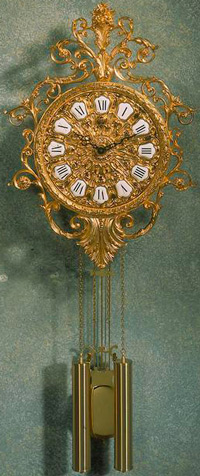
Alfalfa wall clock
|

Alfalfa wall clock
|
Carcass of alfalfa clock was formed by two horizontal solid plates, connected by four corner columns of round cross-section. Typically, a wall with a swivel ear was made of iron, and removable side doors - made of brass. Round watch dial was decorated with engraved figures or floral designs. It was distinguished by Roman numerals engraved between the circles, and the central hand points the clock. The minute indicator appeared on the disc of dials in XVIII century, when there was already a friction clutch for easy rotation of hand regardless of the mechanism. The alfalfa wall clocks were set in motion with stone weights, suspended on ropes (ropes were later replaced with chains). Early models had spindle descent with double-arm balance. Over time, it was replaced by a short pendulum.
Typically, in these clocks were installed two mechanisms: one for the clock and the other - for beating of time. On the cruciform clutch, fixed on the mechanism, to the heads of the angular columns of frame had been suspended a solid bronze bell. The space around it was decorated with carved and engraved items, closing a big round horizontal balance, located above the upper plate of the frame.
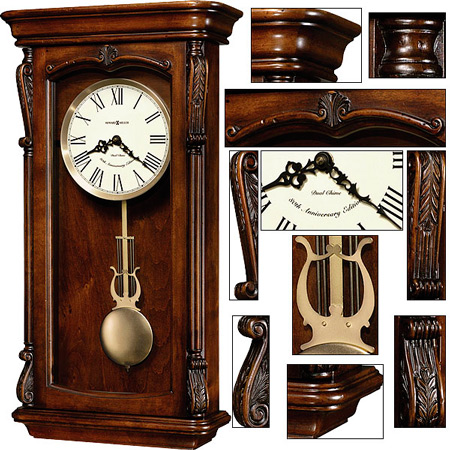
Wall clock
Alfalfa wall clocks, as a rule, except hanging loop also had decorative legs, through which they can be put on the table. At the end of XVI century and at the beginning of the XVII century in Germany were common wall clocks in the form of plates. They were assembled on the basis of the mechanisms of the spindle escapement and a short pendulum in front of round dial.
In the second half of the XVII century in vogue were console watches that were created on the basis of arrangements with a spring drive. They are made with a bracket for wall mounting, with wooden console was made out in the same style as the watch case. The case usually had strong architecture, dial was decorated with various ornaments, in finishing often were used metal inserts, cover plates of wood or tortoise shell. The case was made of high quality wood, the dial – of brass (up to 1750's enameled dials were rare). To manufacture of the console clocks different counties approached differently. In England, the priority was given to mechanisms. A special attention deserved the works D. Tveytsa and E. Nortona - famous artists who belonged to the corporation of London watchmakers. In France, in a prominent position was an aesthetic appeal cases. Cabinetmaker produced luxury cases richly decorated with ornaments, and the mechanisms were ordered according to the size of the finished case.

Wall clock
At the beginning of XVIII century in France in vogue were wall "cartel" clocks, which cases were casted of gilded bronze and decorated with leaf patterns. In the second half of the XVIII century appeared art clocks in which dial disk was inserted into the artistically ornamented composition with landscape or architectural theme. Later of these "art clocks" developed frame: a dial decorated with the stereotype ornament was placed in a gilded frame in Biedermeier or late Rococo style. The most recent and perhaps the most common type of wall clocks were so-called "pendelovki" ("pendulum" clock). The first models of these watches have appeared in Austria in the late of XVIII century and at the beginning of XIX century. Cases of an Austrian "pendelovok" were decorated with carved ornaments and had a rectangular shape. Meanwhile in the U.S., were widespread pendulum clocks with more complex cases (some of which is shaped like musical instruments - banjo, harp, etc.).
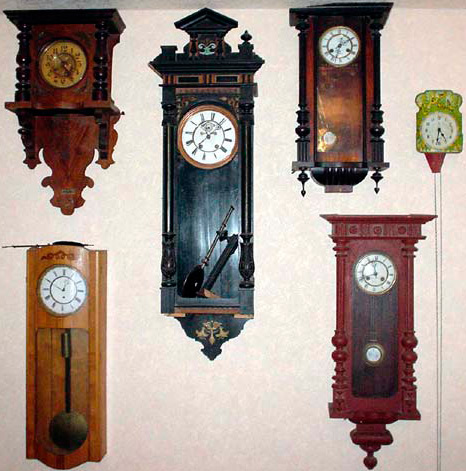
Wall clocks
Wall clocks of XVIII - beginning of XX centuries have great artistic and historical value. Up until the mid XX century, they were a luxury for the main population. The situation changed with the advent of quartz and electronic mechanisms. Production of wall clocks has become widespread, from a luxury they have turned into an everyday household appliance.
In vogue were light and elegant design of cases without any superfluous details and decorative elements. Bulky constructions with towers were displaced by simple cases in which tower and pedestal merged with a case for a pendulum with a distinctive glass door. As before, watch cases mostly were made of wood. Later there were wide popular watches with unusual geometric shapes and unusual combination of materials (such as glass, plastic and metal). In them were mainly used quartz movements, which did not occupy much space and allows actively experiment with the form. The principle of a wall clock creation has not since changed – minimum of mechanism and maximum of design. But the range of used materials has been greatly expanded - metal, wood, porcelain, ceramic, plastic, glass, acrylic, plywood, leather, etc. Development of quartz and electronic technologies allows create a clock of wide range of configuration. There appeared so many design options that come up with something new at times seems an impossible task. But for the human imagination, nothing is impossible. Well, let present to your attention the most interesting developments of modern designers.

Wall clocks
1. Christiaan Postma Clocks Design – this is not just a beautiful part of the interior, but the embodiment of an entire philosophical system. It is the best proof that even in the chaos you can see the order. On a big black clock dial are randomly arranged metal bars that are out of "timeless" chaos are formed in the words for the current time, but rather an hour. Then the name of a number is gradually dissolved, replaced by a verbal symbol of next hour. Miracle of "birth" of numbers from an unordered set of bars is the result of coordinated work of 150 watch mechanisms. Unusual design of a model has been developed by the Dutch designer Christian Postma.
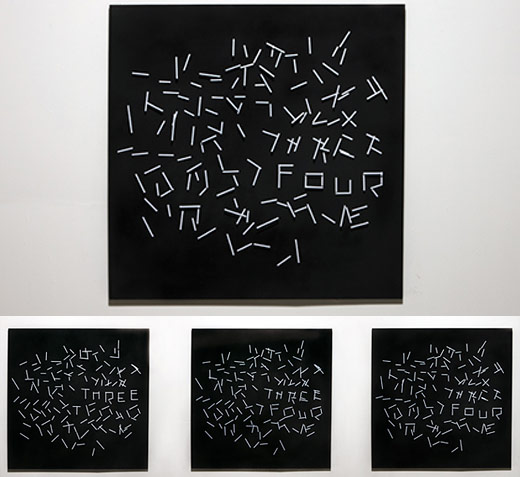
Original clock Christiaan Postma Clocks Design
2. Wall clock ChronArte Canna – is a new look at the flow of time. The creators of the unusual model have managed to demonstrate rapid flow of time. This rectangular clock consists of 12 transparent tubes that are filled with colored water hour by hour, minute by minute. After twelve hours, when the 12-way screen is completely filled with the liquid poured into a special container and a new cycle begins. In this watch the designers have implemented the concept of "time as an endless river." A unique wall model is designed for rooms with more space: height of dial is 121 cm, width - 72 cm.
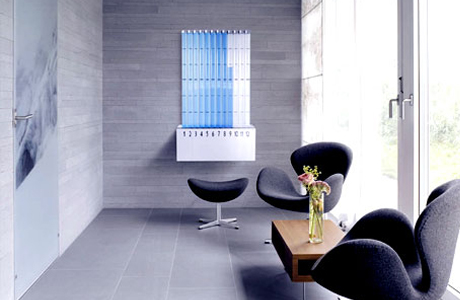
ChronArte Canna wall clock
3. Aspiral Clock – is a clock of British designers Will Aspinall and Neil Lambeth, which, unlike the creators of the previous model, believe that the time is not flowing like a river, but time gyrates. Unusual model is featured with an innovative system of time display. Designers refused traditional central hands, replacing them with the ball.
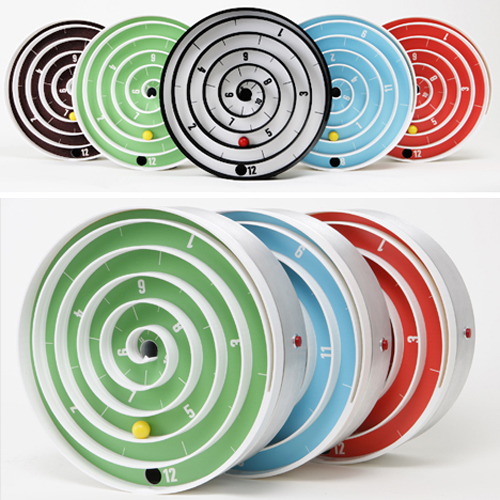
Aspiral Clock
Spiral-dial with 12-hour division turns, moving the ball, pointing hour. Reaching a figure "11", the ball falls into a "black hole" at the center of the dial, and again returned to the track, continuing to count the hours.
4. But the cyclical nature of time is indicated by a clock Catena Wall Clock, created by Andreas Dober in collaboration with the studio Anthologie Quartett. The creative designer replaced the dial and central hands with iron disc and a bicycle chain with brass numerals. A motor located in the center of the iron disk, slowly rotates the chain with time designation: the figure, appeared on the very "top", indicates the current hour. Minutes are determined by the marks on the chain.
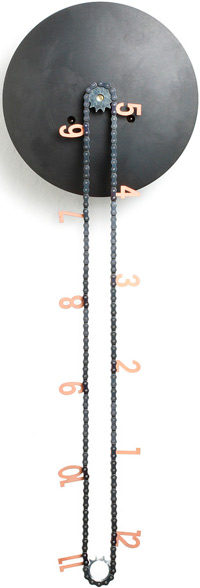
Catena Wall Clock
5. Three-dimensional wall clock Manifold Clock – is a combination of simple machines and modern design, based on a mathematical model of the Riemann surface. Unusual design of the model, that demonstrate the complexity and diversity of time, has been developed by specialists Studio Ve Shay Carmon and Bean Klinger.
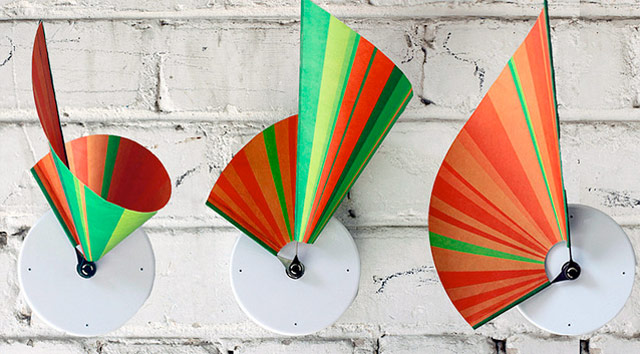
Three-dimensional Manifold Clock
They replaced the traditional central hands with a small piece of decorative polyethylene Tyvek, which is folded and unfolded like a fan, showing parallel time (hours and minutes show the edge of the fan).
6. Continue Time – is an art object and at the same time, well-functioning clock created by Dutch designer Sander Mulder. By his innovative concept, he tried to present time, as something continuous (as indicated by the name of hours - continuous time).
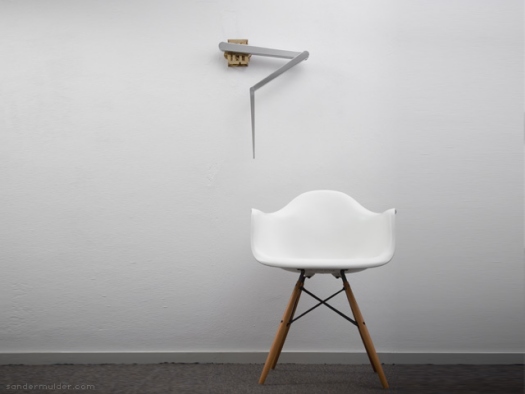
Continue Time – is an art object and well-functioning clock
This clock consists of a visible mechanism and three rotating sections, which are in constant motion and every second form a new composition from informative bends. A section attached to the open mechanism – is an analogue of watch hand from it the minute hand outputs, and the second outputs after the minute. All hands together form a polygonal curve. Dial and case is absent. As the background for the alternately changing hands is used a wall. On colorful patterned wallpaper clock will look unnatural, and for the background is better to choose a blank wall.
The presentation of this clock was held in 2012 in Milan during the Salone del Mobile. The clock is made of brass and aluminum and weighs 4.5 kg. Edition is limited, only 40 pieces.
7. Wall clock Domino Clock, based on motifs of one of the most popular board games - dominoes. The authors of this unusual project are designers of the company Carbon Design Group.
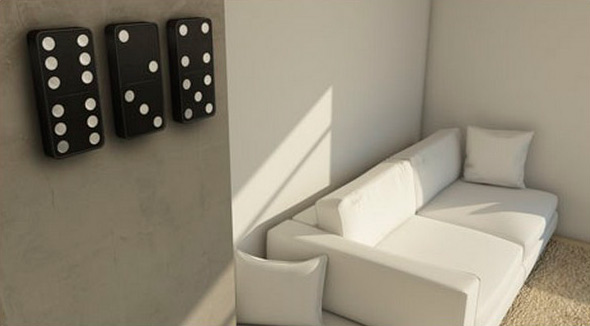
Domino Clock
Domino Clock is three large dominoes, in which instead of the indicators of time are the white dots. The first bead shows the hours (number of hour indexes on the dial corresponds to the number of white dots on the domino), and the second and third - minutes. So, if on the first domino has displayed ten points, the second - two, and the third - 9, the current time 10:29. As you can see, the time on the clock- domino can be determined without difficulty.
8. Linear clock Mhin, designed by a designer James Tobin. On it time is determined by the ruled histogram of hours and minutes. The original concept is built on a simple mechanical drive. Case construction is made of metal and ceramic. Succinctly decorated model fits perfectly into the interior with minimalist design.
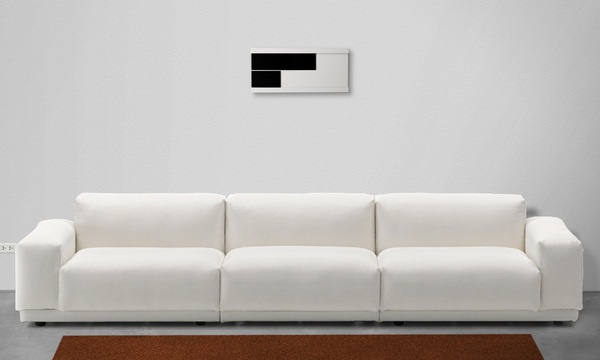
Linear clock Mhin
The distinguishing feature of a wall clock Mhin is silent. Typically, mechanical time devices with their insistent ticking disturb a rest and prevent human strain. James Tobin has saved people from a such torture, offering quiet linear clock Mhin.
9. Wall clock Parallel of time is a complex structure consisting of a connection of central hands of several hours. Hands together form parallelograms, which, in their turn, create the illusion of three-dimensional space within.
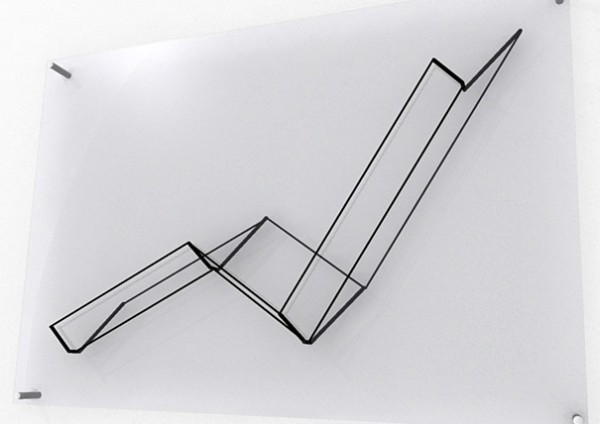
Wall clock Parallel of time
At first glance it may seem that by this clock time cannot be determined. But if you look closely, you can see how complex construction on the wall shows the time and counts down minute by minute. Placed in parallel direction hands of clock movements are synchronized, so between their ends to keep the same distance. Thanks to the coordinated work of the mechanism, it can be determined the position of the central hand and find time for them. To make it clearer, we offer you the following video.
10. Pendulum wall clock is a modern wall clock with pendulum by Nuno Teixeira. This stylish and simple concept is a modern version of traditional pendulum clock for the living room. Apparently, by his development a Portuguese designer wanted to recall that all new - is well forgotten old.
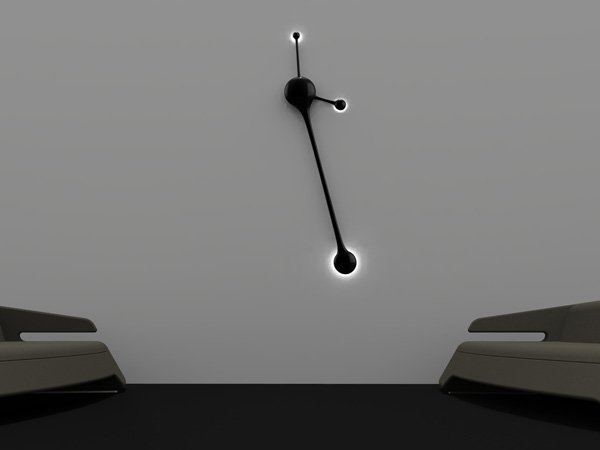
Pendulum wall clock – modern wall clock with pendulum
Pendulum wall clock consists of two central hands and pendulum (works with the power of the magnet) equipped with a LED backlight. If it is interesting how the clock looks in work, you can view a video presented below.
***
In today's world wall clocks are an integral part of the interior. A subject of decoration with original design solution, as known, can revive even the most dismal interior. Choosing a wall clock for a particular room (living room, bedroom, children, etc.), must proceed from its mission and interior features. Modern interior design is different by diverse stylistic decisions. To emphasize the harmony of interior design will help decor items, among which one of the main items are wall clocks.
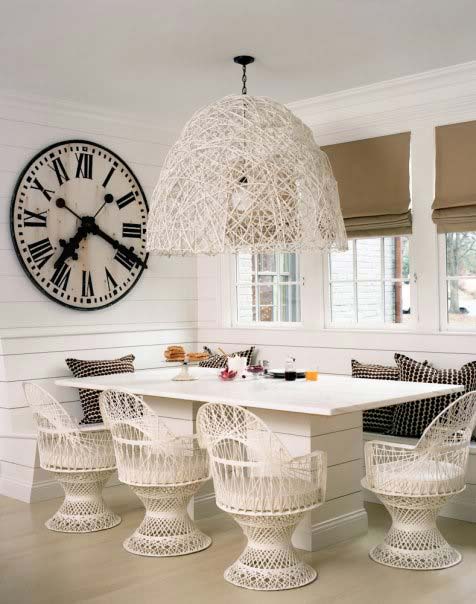
Wall clocks are an integral part of the interior
So, in the homes with classic interior the most suitable are wooden wall clocks (preferably watch case and furniture were made of the same species of wood). Models in cases of plastic, metal and glass perfectly complement the design in the style of hi-tech. But the "ethnic" clocks will become an original touch, as surrounded by classic wood and in combination with white-steel minimalism. In homes where the whole environment is picked up in a country style, perfectly fit a striking clock or cuckoo.
Cuckoo Clock - a classic of the genre
With the development of art of interior design, cuckoo clocks have become an important element in the design of interior spaces. They fit perfectly into the interior of any room - kitchen, bedroom, living room, baby room. The main thing is that the room should be couched in an appropriate style.
Before proceeding to the decorative purpose of these clocks, turn to their history.
|
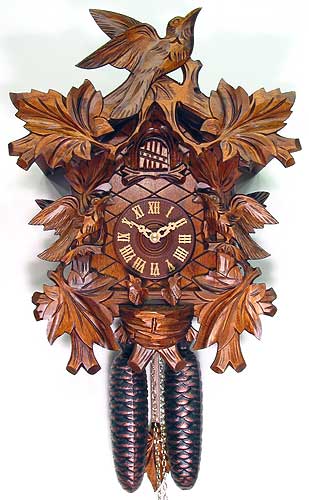
Cuckoo Clock
|
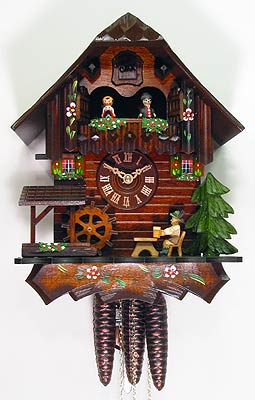
Cuckoo Clock
|
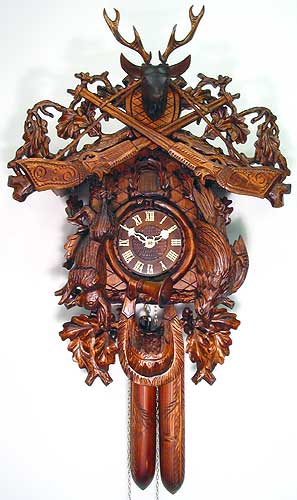
Cuckoo Clock
|
The first cuckoo clock appeared in the middle of the XVIII century in the Schwarzwald - the south-west of Germany. It was created by the clockmaker Franz Anton Ketterer, who lived in the town Schoenwald. Feature of the cuckoo clock is in its soundtrack: every hour or half-hour alarm sounds, imitating the sound of a cuckoo (often accompanied by sound of gong). Ketterer first wanted to create a device that mimics the cock crow, but the musical scale was too complicated. That is why the master stopped for cuckoo for which only it was need only two colors.
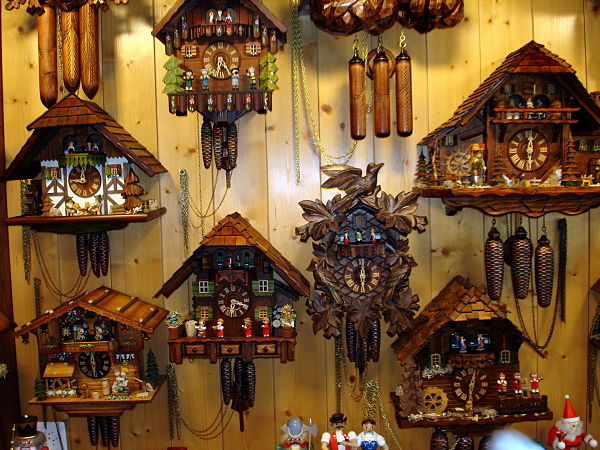
Cuckoo Clock - a classic of the genre
In the first cuckoo clock the whistle b have been connected with lowers, which being filled with air, under their own weight fell one after another, thus imitating the sound of a cuckoo. Later, there were appeared more complex models, in which was used the mechanism of blast bellows and tubes with imitation of cuckoo sound and gong.
The first cuckoo clocks were made entirely of wood (even the wheels of the movement were made of wood and in them only the axis was made of steel) and had only one hand - hours. Attractive design, simple construction, unique wooden ornaments and carvings, a wide variety of movements, the use of natural materials for the manufacture of cases - all these, of course, attract attention.
By the end of XVIII century, the famous Schwarzwald’s clocks have become a symbol of watch making in Germany. They were very popular not only at home, but also far beyond its borders. They were exported to England, Italy, France, Turkey and Russia.
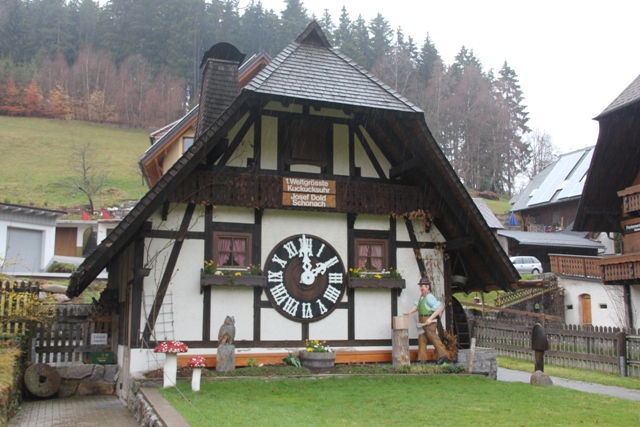
The biggest Cuckoo Clock
Cuckoo clocks made in the Schwarzwald, today, as before, are very popular. In the German town, perhaps, no gift shop, who would not offer buyers the model of all sizes, from tiny of half the size of a matchbox to the real giants in human growth. By the way, in the forests of the Schwarzwald, in Triberg, you can see the largest cuckoo clock. Height of cases is 15.30 meters, the size - 4,50 x 4,50, weight - 6 tons. Pendulum length is 8 m, weight - 100 kg. The cuckoo by itself, which appears periodically to report the current time, weighs 150 kg and its length is 4.5 meters.
Written by SinCera
|


